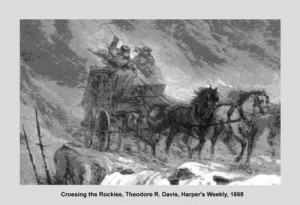Column by John Mattingly
Agriculture – September 2008 – Colorado Central Magazine
I recently received an offer to contribute to a Sustainable Agriculture Think Tank — not my thoughts, but rather surplus cash I might have lying around the stock tank, now that commodity prices are at record high levels.
After the Think Tank elaborated the complex web of ingredients comprising “sustainability,” the group concluded: “But no matter how elegant the system or how accomplished the farmer, no agricultural system is sustainable if it’s not also profitable.”
Stir in the EPA definition of sustainability as: “Meeting present needs without compromising the ability of future generations to meet their needs,” and it would seem “sustainability” could be reduced to an accounting discipline with its own chart of accounts that gives ledger status to present and future needs.
The basics of such an accounting discipline, however, are a long way from common practice. Start with the Think Tank’s directive of profitability. Anyone who has tried to read a corporate earnings report, or followed the book-cooking recipes of certain notorious CEOs, knows that profit can be crunched in many ways. Even Generally Accepted Accounting Principles (GAAP) leave room for fertile minds to work from a desired result backward.
In agriculture, most operators consider it a profitable year if one or all of these is true: (a) income taxes are due, (b) money is in the bank at the end of the year, or (c) the operating loan at the bank is renewed at the beginning of the next year.
Each farming operation has three tiers of accounting: annual (crop inputs and sales), intermediate (machinery, breeding livestock expenses and sales) and long term (land, buildings, and capital expenses and sales). The first two are relatively straight forward: thumbing through bank statements will reveal how much was spent to grow a crop and how much was received for it, and likewise for machinery or livestock purchases and sales, with some special features related to maintenance, repair and depreciation.
But current accounting practice provides few, if any, ledger links between the first two ag accounting tiers and the third. Yet many of the benefits of sustainability require annual costs that yield only long-term benefits. Letting a field go fallow once every seven years, for example, is a benefit to future , sustainable productivity, but results in costs for the fallow year, and current accounting systems don’t have a place to ledger a fallow year as either a contribution to annual profit or to long-term capital benefits. Similarly, many sustainable fertilizers, such as humates and soil amendments, take several years to take effect but must be paid for up front.
THE REVERSE is also true. Many things an operator does to, or with, the ground in one year might result in annual income while reducing key input resources that will leave long-term bills for future operators. Mining an aquifer, depleting the soil’s organic matter, leaving residual toxins, zeroing out trace elements are a few such practices that come to mind.
The fact is, our current accounting systems are not geared to distribute income and expenses, or benefits and costs, for many of the important features of sustainability. On the contrary, current accounting systems tend to steer us into thinking, and acting, very short term: by focusing on the annual bottom line. For sustainability to make broad gains in the ag economy, an expanded chart of accounts is needed that gives ledger status to future costs and benefits.
The relatively new field of Environmental Economics (EE) tries to do just this, identifying a cluster of costs and benefits currently omitted from classical accounting systems and calling these Externalized Costs and Benefits, a label that by its very name indicates they are somehow outside the normal realm, perhaps betraying the trepidation of its creators to fully integrate arguably subjective components into a highly objective system.
For example, EE is equipped to give ledger status to the externalized costs and benefits of coal generated electricity versus solar. Classical accounting concludes that coal costs about 3 cents a kilowatt, solar about 35 cents. But when externalized costs and benefits are included (air pollution and related health costs, water contamination from mining, greenhouse gas emissions, etc.), coal costs about 45 cents a kilowatt and solar about 9 cents.
Similarly, if an EE accounting system is used to compare sustainable ag practices with conventional monoculture agri-business, the sustainable practices make a lot more economic sense. Perhaps the only way to encourage inclusion of EE accounting practices into mainstream ag businesses is through the tax system. Tax deductions, tax credits, depreciation, and other channels in the tax code could be used to steer economic behavior in sustainable directions.
FOR EXAMPLE, if tax credits (not just deductions to gross adjusted income) were allowed for fallowing a field, building organic matter, and using biological pest controls, such practices would become more common, to the long-term benefit of ag systems. There could be abuses of such hearty tax benefits — clever folks might buy land to fallow that never had been farmed — but regulatory reins could contain most of that, and the prospect of such abuses has to be measured against the current level of abuse to the future productive capacity of national ag lands.
In addition to its sometimes daunting subjective nature, EE accounting practices haven’t made it into mainstream accounting practice because humans have a hard-wired resistance to long-term accountability. Short term has characterized most human activity since we began walking on two legs, perhaps because there really hasn’t been a great contribution to species fitness from planning, thinking, and accounting too far ahead. A lot changes in the intervening years that can render elaborate plans irrelevant. And there seems to be some benefit from an older generation leaving behind a few tough problems for the successor generation to solve, as these problems create a coil of stresses that generally build vigor in the species.
FINALLY, BRINGING IN THE REALITY of known physics, matter does not become more organized without inputs of energy, and because energy is ultimately limited, disorganization (aka entropy) will triumph in the end. Our farm fields, our nation, our planet, our solar system, and even our universe are not sustainable. Everyone, everywhere, everything, ends — at least, so far.
Humans are probably the first species to figure this out, and we are probably the only species in search of theories that will give us an edge against entropy, just as the germ theory gave us an edge against disease. Clues to an entropy-taming theory may arise in surprising places. Just as Semmelwies, a humble physician, opened the door on the germ theory by simply washing his hands, entropy may be tamed by a humble farmer, sustaining his fields.
John Mattingly is a recovering farmer now abiding in Creede, where the growing season is too short for sustainability.


